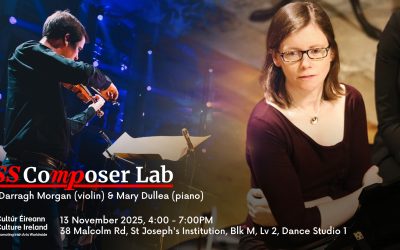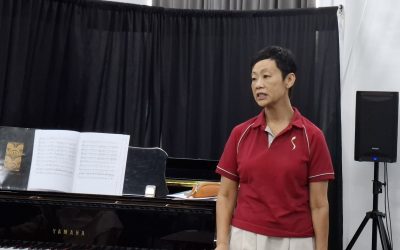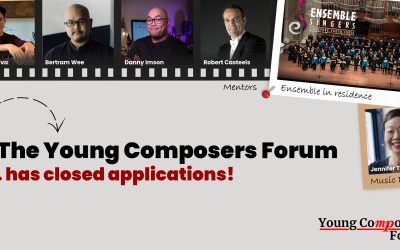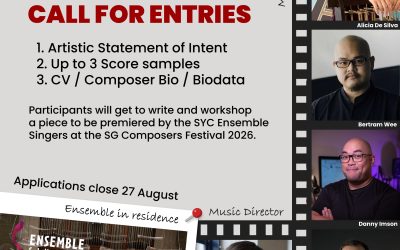Contributed by Tan Zheng Rui
The evening celebrating their 60th anniversary last year still feels as fresh as yesterday. Intrepid programming of works from composers local and abroad, which included the crème de la crème Te Deum by Arvo Pärt and a world premiere, suffused this “yesterday” with intimacy and warmth. It was heartening to witness them scale this monumental piece by Pärt. On this evening of 16 Aug, as they sang “the goal of living is to grow; the aim of waking is to dream” from a text by e.e. cummings, these lines echoed out sentiments of the stages of preceding years. Tonight naturally became a sequel.
SYC Ensemble Singers’ concert this evening united and reminisced several contemporary choral works from local composers. This age milestone brings about an almost-immediate concomitant association with the nation’s 60th birthday. In some ways I posit that the ensemble’s growth and achievements today are rather intertwined with those of our nation’s. Artistic Director and Conductor Jennifer Tham once joined the choir as a singer in 1981, and has been conducting it since 1986. Their sense of purpose in championing choral works of living composers and serving as a collective for innovation remains unwavering, and undeniably successful.
This concert, titled “the body electric”, takes its name from a piece of the same name featured in this concert. It is the ensemble’s legacy-memory project, originally slated to premiere last year as part of its 60th anniversary celebration. Conceived as a “choral theatre” by Americ Goh, Diana Soh and Tham, this work spanned a little more than 30 minutes, similar to the duration of Te Deum, while comprising nine episodes. Tham reflected on how each episode in this piece captured each singer’s journey, as well as the choir’s collective growth and experience in music-making. Besides, this piece was thoughtfully staged and planned — lighting, movement, technology along with “singing” and “body”. The composers pondered upon how the human body is a vessel to sound. This extrapolated to the exploration of the “singing body”, which is a mutual relationship between sound and the human body being its mirror and sculptor. Chekhov’s 11 types of archetypal gestures is one that bridged this relationship. Each of these gestures, in a playwright context, is the “largest possible gesture of primal intention”. These gestures transform to be psychological gestures once it is infused with the character’s deepest intention, practised repeatedly, and ultimately internalised. Seven of them were selected as those were what the composers felt to be more musical. Each of these singers acted an assigned gesture while emerging from the perfused silence at the start.

Along with the various lighting arrangements and different formations in which they stood, this choreography utilised the space they had to its fullest potential. This sonic experience was elevated once the show arrived at its final episode. Audience members were invited to indirectly be part of the music. A private network linked everyone to a private site for us to answer a question. Each individual response was then mapped to a distinct audio track within this sonic field. This field contained about 5000 distinct sounds – each of varying length and nature. These audio track(s) would become the sonic background which the choir sang against. The effect from this process was hauntingly beautiful – various lines superimposed, hovered interweaved with the choir’s vocal timbre. While I hoped certain sections of music were less static, this piece was generally paced quite well.

Joyce Koh’s Nona Sensilia and Hoh Chung Shih’s Variations (on a brink) were programmed after one another in the first half of the evening’s show. Their reappearances were timely — both were commissioned more than 25 years ago, and had resurfaced from the repository of local choral works. They were just two of which that forged the sonic memory of the ensemble.
With regards to Koh, her use of word painting captured the robust and playful nature of her texts. While the texts themselves did not convey any coherent meaning, the focus was placed on how each of these words were read. Often an innate pulse was present when groups of words were read together, in turn creating momentum within this passage. Nevertheless, certain groupings or set of words were more emphasised , especially those with rhymes or alliterations.
Hoh was inspired by the blooming local contemporary music, by extrapolation, and the arts scene in that milieu. He chose a poem, more specifically a spatial poem, by a local poet which resonated similar sentiments. Spatial poems draw an additional focus to the unique visual arrangement of words and lines. This uniqueness overlays additional meanings to the poem. With respect to Hoh’s text chosen to be set, there are multiple ways of reading this poem from top-down. Each method of reading, henceforth, opens up fresh perspectives on how this poem can be interpreted. Hoh reflected this extramusical idea of the potential of multiple interpretations due to the nature of this poem through stasis in his sections. Initial long glissando tones sprinkled with fragments of whispers and speakings morphed into chromatic lines which lead into nowhere. The linearity in form lent the clarity of the process of morphing in his piece.

While SYC Ensemble Singers has wrapped up their generous, introspective and unapologetic musical offering this evening, their upcoming collaboration with Composers Society of Singapore (CSS) will be much anticipated. SYC Ensemble Singers will be the ensemble in residence for the Young Composers’ Forum (YCF) 2025 edition. Selected young composers will work with mentors and the ensemble in residence for a 6 months creative period, with workshops and consultations in place. These works, as well as a new work each written by their mentors, will be premiered next year during the Singapore Composers Festival. We look forward to witnessing more years of music-making with them.











